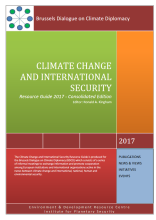Land Library
Welcome to the Land Portal Library. Explore our vast collection of open-access resources (over 74,000) including reports, journal articles, research papers, peer-reviewed publications, legal documents, videos and much more.
/ library resources
Showing items 1 through 9 of 20.The Climate Change and International Security Resource Guide is produced for the Brussels Dialogue on Climate Diplomacy (BDCD) which consists of a series of informal meetings to exchange information and promote cooperation among European institutions and international organisations active in the
Conflict and climate change have pushed 124 million people in 51 countries into acute food security, a situation when the inability to consume adequate food represents an immediate danger to people’s lives and livelihoods.
The Sendai Framework for Disaster Risk Reduction (DRR) is a non-legally binding agreement designed to reduce existing levels of risk and prevent emerging risks.
This study represents an initial attempt to assess patterns of displacement related to droughts in selected countries of the Horn of Africa, specifically the border regions of Kenya, Ethiopia and Somalia.
Pastoralism is a global phenomenon. In Africa, where 66 per cent of is used for pastoral production, it is recognised as part of the continent’s cultural heritage.
The scale and speed of coordinated land grabs over the past five years has created a new avenue through which people are being displaced and dispossessed of their lands. This paper looks at what limits international and national law in addressing displacement and dispossession due to land g
The development of international mining projects is one of the most visible consequences of globalisation. But developments in the mining industry are the cause of about 10.3 percent of all displacements in the world.
This paper analyses issues that affect the role of agriculture as a source of economic development, rural livelihoods and environmental services.
This policy brief explores the importance of land issues in forced displacement in Kenya, drawing out their implications for current humanitarian and early recovery interventions in the wake of the violence and displacement that followed the 2007 elections. Key messages nclude:




